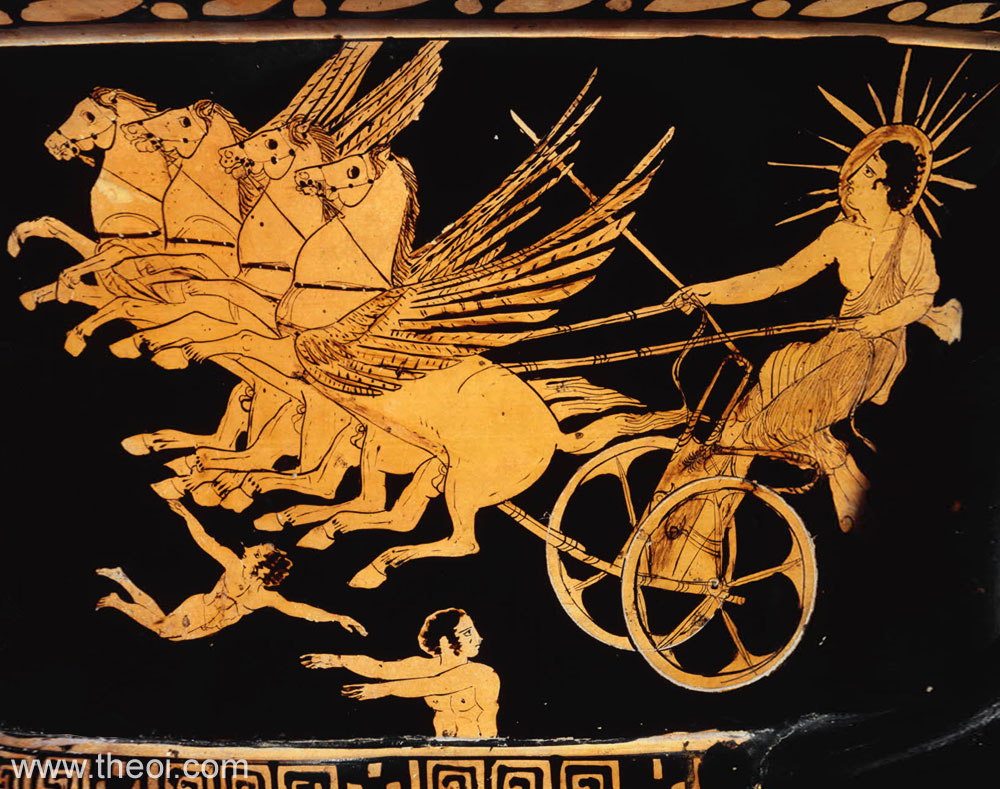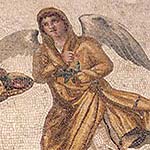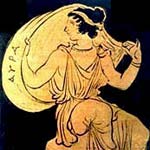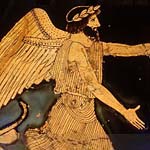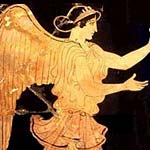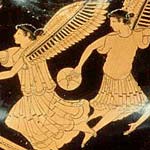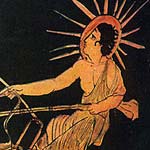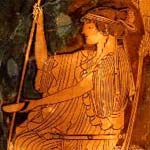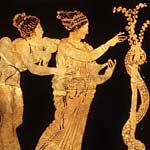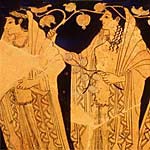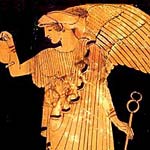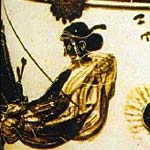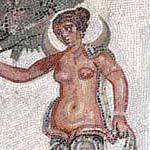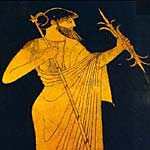SKY GODS
The gods of sky and weather were named "Theoi Ouranioi" or "Theoi Meteoroi" by the Greeks. They were under the command of Zeus and Hera, the king and queen of heaven.
A COMPLETE LIST OF GREEK SKY GODS & GODDESSES
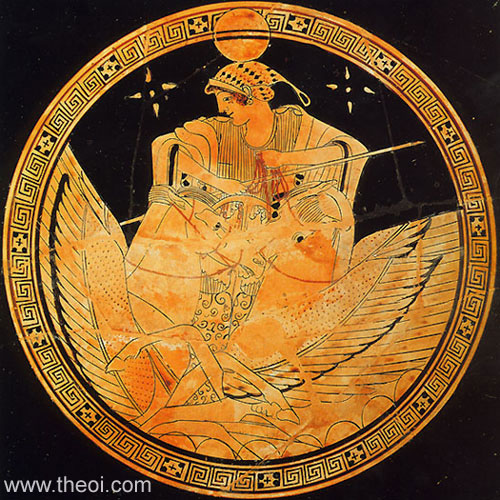
AEOLUS (Aiolos) The king of the winds. He was appointed by Zeus to guard the storm winds which he kept locked away inside the floating island of Aeolia, releasing them at the request of the gods to wreak their havoc.
AETHER (Aither) The primeval god of the shining light of the blue sky. He was conceived of as the substance of light, a layer of bright mist which lay between the dome of heaven and the lower air which surrounded the earth.
ANEMI (1) (Anemoi) The gods of the four directional winds and the heralds of the four seasons. Boreas the north wind was the lord of winter, Zephyros the west was the bringer of spring, Euros the east was the god of autumn, and Notos the south of summer.
ANEMOI (2) The Daemones of the violent storm-winds. They were sons of the monster Typhoeus kept locked away inside Tartarus or the floating island of Aeolus to be released only at the command of the gods.
ARCE (Arke) The messenger of the Titans. She was the sister of Iris and the goddess of the lost second rainbow. At the end of the Titan-war she was stripped of her wings and locked away inside the pit of Tartarus.
ASTRAEUS (Astraios) The Titan god of the stars. He was father of the planets and the four seasonal winds by Eos the dawn.
ASTRA PLANETI (Astra Planetoi) The gods of the five wandering-stars or planets. The leader of these was bright Eosphoros, the god of the dawn-star Venus. The other four were Pyroeis (star Mars), Phaenon (star Saturn), Phaethon (star Jupiter) and Stilbon (star Mercury).
ASTROTHESIAE (Astrothesiai) The spirits or living forms of the heavenly constellations. They were mostly heroes and creatures who were placed amongst the stars by the gods as reward for some service or, in a handful of cases, as a memorial of their crimes.
ATLAS A Titan condemned by Zeus to hold the sky aloft upon his shoulders and turn it upon its axis. Homer in the Odyssey seems to suggest that he was released from this labour and appointed keeper of the pillars of heaven, presumably the ones erected by Heracles at the ends of the earth.
AURA The Titan goddess of the breeze.
AURAE (Aurai) The nymphs of the breezes.
BOREAS The god of the north wind whose wintry breath brought the cold of winter. He dwelt in a cave in the mountains of the far northern land of Thrace.
CHAOS (Khaos) The primeval goddess of the gap between heaven and earth. She was the air which men breathed. Below Chaos her lay the flat body of the earth, and above the shining mists of the protogenos Aether. Chaos was the mother of Darkness and Night and of the birds.
CHIONE (Khione) The goddess of snow. She was daughter a daughter of Boreas, god of the wintry north wind.
CHRONOS The old god of time who turned the wheel of the heavenly constellations. He was sometimes equated with Cronus, the father of Zeus.
CYCLOPES (Kyklopes) Three giant sons of Uranus (Heaven) who forged the lightning and thunder of Zeus. Their three brothers, the Hecatoncheires, were the gods of violent storms.
EOS The winged goddess of the dawn. She heralded the rising of the sun with her rosy brilliance.
EOSPHORUS (Eosphoros) The god of the dawn-star (the star Venus) seen in the morning skies. He was originally regarded as being distinct from Hesperus, the god of the evening star.
EURUS (Euros) The god of the east wind and herald of the autumn season.
HARPYIAE (Harpyiai) Daemones of whirlwinds and storm gusts. They were known as the hounds of Zeus and blamed for the dissappearance of people without a trace.
HECATONCHEIRES (Hekatonkheires) Three hundred-armed, fifty-headed giants. They were the gods of violent storms which they released from the gates of Tartarus.
HELIUS (Helios) The god of the sun whose orb was he wore upon his head as a bright aureole crown. Helios drove a fiery chariot drawn by four winged steeds.
HEMERA The primeval goddess of the day. In the early morn she scattered the mists of her mother Nyx (Lady Night), to reveal the shining light of Aether, the blue sky.
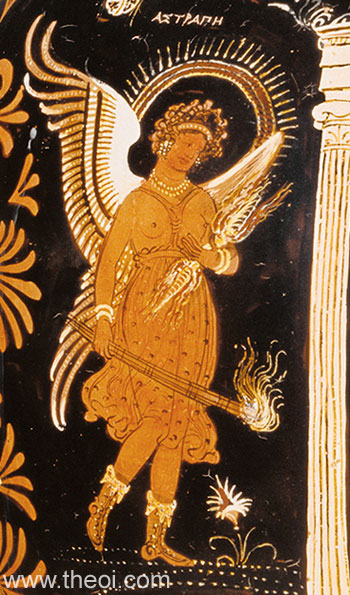
HERA The Queen of Heaven and goddess of the air and starry constellations. The Milky Way was spilt from her breast and most of the other constellations placed in the heavens at her command.
HERSE The goddess of the morning dew.
HESPERIDES The goddesses of sunsets. The three Hesperides tended the tree of the golden apples on Erythea, the Red Isle, in the western stream of the river Oceanus. The apples were a wedding present from Gaea to the sky-gods Zeus and Hera. They were the source of the golden light of sunset, created to celebrate the nuptials of the sky-gods.
HESPERUS (Hesperos) The god of the evening star (the planet Venus). He was originally distinct from his stellar counterpart Eosphorus, the dawn-star.
HORAE (1) (Horai) Three goddesses of the seasons and the ordering of time named Eirene, Eunomia and Dike. They directed the constellations and guiding the Sun in his heavenly course.
HORAE (2) (Horai) The goddesses of the twelve hours of the day. They were originally the same as the first three mentioned above.
HYADES Nymphs of the five stars of the constellation Hyades. They were daughters of the Titan Atlas. Their rising marked the start of the rainy month of spring.
IRIS The goddess of the rainbow. She was the divine messenger of the Olympian gods.
MENAE The nymphs of the fifty new moons of the Olympiad (a period of four years). Fifty moons were significant because this number marked the conjunction of solar and lunar calendars. The goddesses themselves were daughters of the moon-goddess Selene.
NEPHELAE (Nephelai) The nymphs of the clouds. They were daughters of the earth-encircling, river Oceanus from whose waters they drew the rain.
NOTUS (Notos) The god of the wet and stormy south wind who heralded the month of summer.
NYX The primeval goddess of night. In the evening Nyx drew her curtain of dark mists across the sky, cloaking the light of her son Aether, the shining blue sky. In the morn, her daughter Hemera (the goddess Day) lifted the dark mantle.
OCEANIDES (Okeanides)The daughters of the earth-encircling river Oceanus. Some of these were nymphs of clouds (Nephelae) and moistening breezes (Aurae).
OREITHYIA The goddess of cold, gusty mountain winds. She was the wife of Boreas, the wintry north wind, and the mother of Chione, snow.
PLEIADES The nymphs of the seven stars of the constellation Pleiades. They were daughters of the Titan Atlas whose rising and setting were of key importance in the agricultural calendar.
SELENE The goddess of the moon. She rode across the sky on the back of a bull, an ass, or in chariot drawn by winged horses. The moon itself was her crown or billowing veil.
URANUS (Ouranos) The primeval god whose body formed the solid dome of heaven. The Greeks imagined him as a bronze-bodied, star-spangled god whose hands rested upon the earth in the farthest east and feet in the farthest west. He was similar in form to the Egyptian goddess Nut whose starry arching form is common in art. Uranus was a eunuch god, having been castrated by Cronus at the beginning of time.
ZEPHRYUS (Zephyros) The god of the gentle west wind and the herald of spring. He was the husband of Chloris, the goddess of flowers, and the father of Carpus, fruits.
ZEUS The King of the Gods and the ruler of the heavens. He was the god of clouds, rain, thunder and lightning.
ZODIAC (Zodiakos) The spirits of the twelve constellations of the zodiac circled heaven measuring the seasons of the year.
